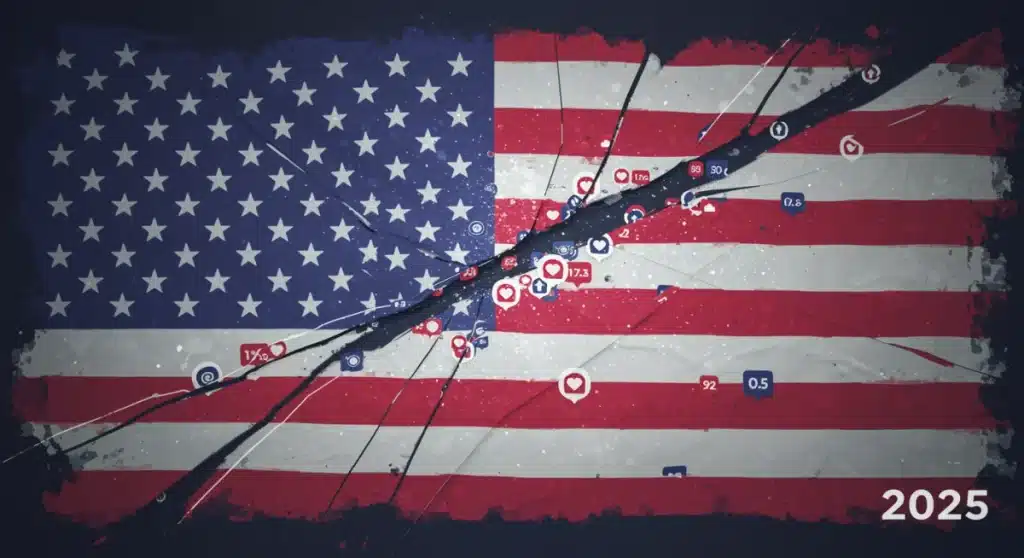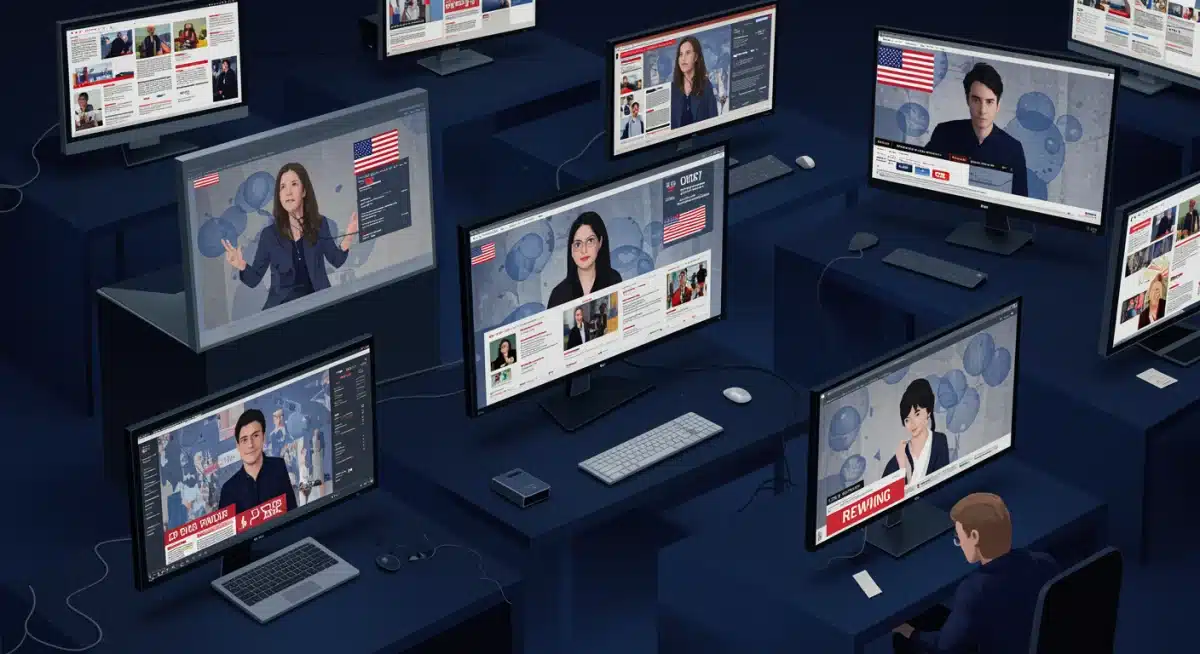Political Polarization in 2025: Social Media’s Election Impact

Forecasting reveals significant potential for social media to exacerbate political polarization in the 2025 US elections, potentially influencing a 15% voter shift through targeted narratives and echo chambers.
The landscape of American politics is bracing for significant shifts, with projections indicating that political polarization in 2025 will intensify, largely driven by the pervasive influence of social media on US elections. Experts are now forecasting a potential 15% voter shift, underscoring the urgent need to understand these dynamics.
The Accelerating Divide: Social Media’s Role
Social media platforms are increasingly central to political discourse, acting as both conduits for information and amplifiers of division. In 2025, their role in exacerbating political polarization is expected to reach new heights, fundamentally altering how voters engage with candidates and issues.
Recent analyses from think tanks like the Pew Research Center indicate that algorithms designed for engagement often prioritize emotionally charged content, which tends to be polarizing. This creates a feedback loop, pushing users further into ideological silos and making cross-partisan dialogue more challenging.
Echo Chambers and Filter Bubbles
The phenomenon of echo chambers and filter bubbles is not new, but its sophistication and reach are evolving. Social media platforms, through personalized algorithms, curate content that aligns with a user’s existing beliefs, inadvertently shielding them from dissenting viewpoints. This creates an insulated environment where confirmation bias thrives.
- Content Reinforcement: Algorithms prioritize content that users are likely to interact with, often leading to a steady diet of ideologically aligned information.
- Reduced Exposure: Users are less exposed to diverse perspectives, limiting their ability to critically evaluate opposing arguments.
- Increased Extremism: Constant exposure to one-sided narratives can push individuals towards more extreme political stances, solidifying their positions and making compromise difficult.
Forecasting a 15% Voter Shift: Underlying Factors
The projection of a 15% voter shift in the 2025 US elections is a stark warning. This shift is not merely about changing party allegiance but reflects a deeper realignment influenced by information consumption patterns and the emotional resonance of online political messaging. Several factors contribute to this significant forecast.
One primary driver is the increasing efficacy of micro-targeting campaigns. Political strategists are leveraging vast datasets gleaned from social media activity to tailor messages to specific demographics, often bypassing traditional media outlets. This allows for highly personalized, and often emotionally manipulative, appeals that can sway undecided voters or mobilize latent supporters.
The Power of Disinformation and Misinformation
The spread of disinformation and misinformation continues to be a potent force. In 2025, advanced AI and deepfake technologies are expected to make false narratives even more convincing and harder to detect. These fabricated stories can significantly impact public opinion and erode trust in democratic institutions.
- AI-Generated Content: Sophisticated AI tools can create realistic fake news articles, videos, and audio clips that are indistinguishable from authentic content.
- Rapid Dissemination: Social media’s viral nature ensures that disinformation spreads rapidly, often reaching millions before fact-checkers can intervene.
- Erosion of Trust: A constant barrage of false information makes it difficult for voters to discern truth from fiction, leading to cynicism and disengagement or greater reliance on partisan sources.
Campaign Strategies in the Digital Age
Political campaigns are adapting rapidly to this new digital reality. The focus has shifted from broad, televised appeals to highly granular, platform-specific engagement. In 2025, campaigns will likely intensify their use of social media for direct voter contact, fundraising, and narrative control.
This includes deploying teams of social media strategists to monitor online conversations, respond to criticisms in real-time, and flood platforms with positive messaging. The goal is not just to inform, but to persuade and mobilize through constant, tailored communication. The effectiveness of these strategies directly correlates with the projected voter shift.
Influencer Marketing and Grassroots Digital Organizing
The rise of political influencers on platforms like TikTok and Instagram represents a new frontier for campaigns. These individuals, often seen as more authentic than traditional politicians, can sway younger demographics and energize specific voter bases. Additionally, digital grassroots organizing allows campaigns to quickly mobilize supporters for online actions, such as sharing content or participating in virtual rallies.

Regulatory Challenges and Platform Accountability
As the impact of social media on political processes becomes undeniable, so too do the calls for greater regulation and platform accountability. Governments worldwide are grappling with how to balance free speech with the need to combat disinformation and mitigate polarization. In the lead-up to 2025, these debates are intensifying.
The challenge lies in creating regulations that are effective without stifling innovation or infringing on fundamental rights. Many argue that platforms themselves bear significant responsibility for the content they host and amplify, pushing for more proactive moderation and transparency in their algorithms.
Proposed Solutions and Their Efficacy
Various solutions are being proposed, ranging from stricter content moderation policies to algorithm transparency and user education. However, the implementation of these measures faces significant hurdles, including technological complexity, political resistance, and the global nature of social media companies.
- Algorithm Audits: Independent audits of social media algorithms could shed light on how content is amplified and identify biases.
- Fact-Checking Partnerships: Enhanced partnerships with independent fact-checking organizations can help identify and label false information more quickly.
- Digital Literacy Programs: Investing in educational programs to improve digital literacy can empower users to critically evaluate online content.
The Human Element: Psychological Impact of Polarization
Beyond the technological and political aspects, the human cost of increasing political polarization is significant. Constant exposure to divisive content and the erosion of common ground can lead to heightened anxiety, distrust, and even strained personal relationships. The psychological toll impacts individual well-being and societal cohesion.
Research suggests that individuals in highly polarized environments often experience greater stress and a reduced capacity for empathy towards those with differing views. This creates a vicious cycle where emotional responses override rational discourse, further entrenching divisions.
Social Media’s Impact on Mental Health
The mental health implications of social media, particularly in a politically charged environment, are a growing concern. The constant stream of negative news, combined with online harassment and the pressure to conform to group ideologies, can contribute to feelings of isolation and despair. This psychological vulnerability can, in turn, make individuals more susceptible to manipulative political messaging.
Mitigating Polarization: A Path Forward
Addressing the escalating political polarization in 2025 requires a multi-faceted approach, involving not only technological solutions and regulatory frameworks but also a renewed commitment to civic education and fostering healthier online communities. It is a shared responsibility that extends to platforms, policymakers, educators, and individual users.
Promoting media literacy, encouraging critical thinking, and supporting initiatives that facilitate constructive cross-ideological dialogue are crucial steps. The goal is to create a digital environment where diverse perspectives can coexist without devolving into hostility, thereby safeguarding the integrity of democratic processes.
Community-Driven Solutions and Responsible Usage
Empowering users to be more discerning consumers and creators of online content is vital. This includes promoting responsible sharing practices and encouraging individuals to actively seek out diverse news sources. Community-driven moderation and the development of alternative platforms that prioritize civil discourse over engagement-at-all-costs could also play a significant role.
| Key Point | Brief Description |
|---|---|
| Social Media Amplification | Algorithms boost emotionally charged, polarizing content, creating echo chambers and ideological silos. |
| 15% Voter Shift Forecast | Projected realignment of voter preferences driven by micro-targeting and pervasive online narratives. |
| Disinformation Threat | Advanced AI and deepfake technologies will make false narratives more convincing and widespread, eroding trust. |
| Regulatory Challenges | Governments struggle to balance free speech with combating disinformation and platform accountability. |
Frequently Asked Questions About Political Polarization
Social media exacerbates polarization by using algorithms that prioritize engaging, often emotionally charged content. This creates echo chambers, reinforcing users’ existing beliefs and limiting exposure to diverse viewpoints, thereby deepening ideological divides.
A 15% voter shift suggests a substantial realignment of electoral support, potentially altering election outcomes significantly. This shift is driven by effective micro-targeting, the spread of disinformation, and the emotional impact of online political campaigns.
Yes, AI and deepfakes pose a significant threat to election integrity. These technologies can generate highly convincing false narratives, images, and videos that are difficult to distinguish from reality, potentially misleading voters and eroding trust in official information sources.
Regulating social media involves balancing free speech with the need to combat disinformation and harmful content. Challenges include defining what constitutes harmful content, ensuring global compliance, and avoiding censorship while promoting platform accountability and transparency.
Individuals can mitigate polarization by actively seeking diverse news sources, critically evaluating information, engaging in respectful dialogue, and being mindful of their own social media consumption habits. Promoting digital literacy is also a crucial personal step.
What Happens Next
As 2025 approaches, the interplay between social media and political polarization will remain a critical area of focus. We anticipate ongoing debates surrounding platform regulation, with increasing pressure on tech companies to address their role in shaping public discourse. The effectiveness of new campaign strategies leveraging AI and micro-targeting will be closely watched, as will the societal impact of sustained digital division. Watch for legislative proposals and civil society initiatives aimed at fostering a more informed and less polarized electorate.





